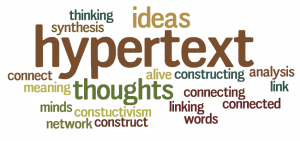Hypertext
Debate surrounds the concept of hypertext and has existed since the technological form of creating links, nodes, connections and relationships was named. Viewpoints and understandings differ about what it means, how it can be used, and why it is important. The debate evolves from individual’s unique associations, mental constructs and epistemic beliefs about this medium of communication.
The term ‘hypertext’ is attributed to Ted Nelson and connected to the writing of Vannevar Bush. Hypertext is linked to the work of Tim Berners Lee and standardized by the W3C, a worldwide consortium dedicated to improving the structures and affordances of hypertext. One definition, as presented on the Electronic Labyrinth states:
“Hypertext is the presentation of information as a linked network of nodes which readers are free to navigate in a non-linear fashion. It allows for multiple authors, a blurring of the author and reader functions, extended works with diffuse boundaries, and multiple reading paths.” (Keep, McLaughlin, Parmar, 2002)
Many see hypertext as reflective of how the human mind works. This is attributed to Vannevar Bush’s statement reflection that the human mind works “by association. With one item in its grasp, it snaps instantly to the next that is suggested by the association of thoughts, in accordance with some intricate web of trails carried by the cells of the brain.” (1945) Others note that hypertext is “the remediation of print” (Bolter, 2001, p. 46).
Hypertext systems exist on a continuum from association to connection. (Bardini, 1997). Debate abounds about how readers and writers engage and relate to hypertext material (Harrison, 2002; Miall & Dobson, 2001; Jonassen, 1991). The affordances of hypertext communication extend these debates. Hypertext, simultaneously viewed as associative, relational and non-linear, is undeniably a powerful means for human interaction and communication.
For educators, working with learners within this medium, it is necessary to be aware of diverse viewpoints and specific affordances. It is essential to keep all the myths (Dillon, 1996), understandings and interconnected ideas in mind, while constructing individual learning with hypertext materials.
